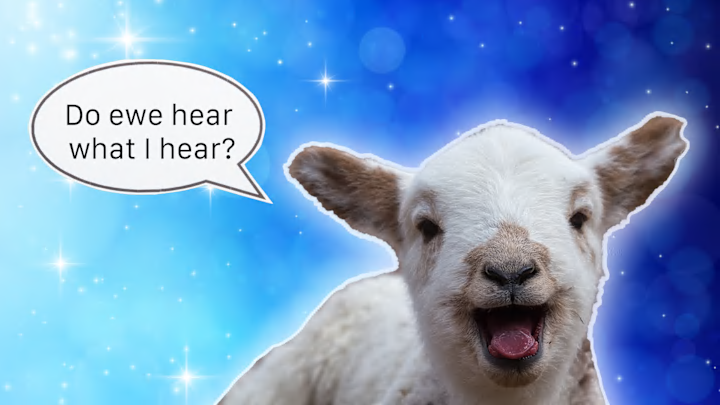For all its very logical and sensible legends and traditions, Christmas has quite a few strange ones too (like, say, gravity-defying reindeer). Some rare bits of Christmas mythology are even stranger still—like the one that claims that at the stroke of midnight on Christmas Eve, animals gain the power of speech.
Tidings of Vengeance and Death

The legend—most common in parts of Europe—has been applied to farm animals and household pets alike. It operates on the belief that Jesus’s birth occurred at exactly midnight on Christmas Day, leading to various supernatural occurrences. Many speculate that the myth has pagan roots or may have morphed from the belief that the ox and donkey in the Nativity stable bowed down when Jesus was born. In any case, the story has since taken on a life of its own, with different versions ranging from sweet to scary.
According to The Christmas Troll and Other Yuletide Stories by Clement A. Miles, variations of the legend can be surprisingly sinister for holiday lore. One tells the story of vengeful pets plotting against their masters, like this tale from Brittany:
“Once upon a time there was a woman who starved her cat and dog. At midnight on Christmas Eve she heard the dog say to the cat, ‘It is quite time we lost our mistress; she is a regular miser. To-night burglars are coming to steal her money; and if she cries out they will break her head.’
‘Twill be a good deed,’ the cat replied. The woman in terror got up to go to a neighbor's house; as she went out the burglars opened the door, and when she shouted for help they broke her head.”
Another tale, this time hailing from the German Alps, features animals foretelling their caretakers’ death. On Christmas Eve, a young farm servant hides in the stables hoping to witness the animals’ speech, where he overhears an alarming conversation between two horses:
“We shall have hard work to do this day week,” said one horse.
“Yes, the farmer's servant is heavy,” replies another horse.
“And the way to the churchyard is long and steep,” says the first.
The servant dies a few days later, leaving those horses to do some heavy lifting.
Away in a Manger
A more modern version of the tale first aired on ABC in 1970, and while it’s animated and for children, it’s still surprisingly grim. In the made-for-TV cartoon titled The Night The Animals Talked, animals gain the power of speech and sing a song exalting their newfound ability—to insult each other: “You can bicker with anyone you hate / It’s great to communicate.”
By the time the animals realize that they’ve been given the ability in order to spread the message of Jesus’s birth, it’s too late. While running through the streets of Bethlehem, they lose their speech one by one. The ox, last to lose the ability, is left to lament that so many humans seem to waste the gift of speech.
And then there’s “The Friendly Beasts,” a lighter version of the legend in the form of a Christmas carol. The hymn takes a less literal approach to the “talking animals” theory, instead focusing more on the connection each animal had to Jesus’s birth: “’I,’ said the donkey, shaggy and brown, ‘I carried His mother up hill and down; ‘I,’ said the cow, all white and red, ‘I gave Him my manger for His head,’” and so on with the sheep and dove.
The song’s origins purportedly lie in a mostly forgotten French medieval feast day, the Fete de L’Ane, or the Feast of the Ass, which honors Mary, Jesus, and Joseph’s flight into Egypt, and the donkey who transported them. The carol was born of an early Latin hymn commonly sung at the feast, “Orientis partibus Adventavit asinus," or “From the East the ass has come,” which included a chorus of “Hail, Sir donkey, hail!”
Christmas Bees Are Singing

The variations of Christmas legends about special or supernatural animal behavior are diverse and far-reaching. Not all necessarily involve animals speaking. In John Howison’s 1821 Sketches of Upper Canada, the author recounts a Native American who told him that “[It’s] Christmas night and all deer fall upon their knees to the Great Spirit.” William Henderson’s 1879 book Folk-lore of the Northern Counties of England and their Borders recounts the legend that, on Christmas Eve, bees assemble into a type of choir:
“Thus the Rev. Hugh Taylor writes: ‘A man of the name of Murray died about the age of ninety, in the parish of Earsdon, Northumberland. He told a sister of mine that on Christmas Eve, the bees assemble and hum a Christmas hymn, and that his mother had distinctly heard them do this on one occasion when she had gone out to listen for her husband’s return. Murray was a shewd man, yet he seemed to believe this implicitly.’”
In some cases, the myth of the singing bees circles back to that of the kneeling oxen: “[…]In the parish of Whitebeck, in Cumberland, bees are said to sing at midnight as soon as the day of the Nativity begins, and also that oxen kneel in their stalls at the same day and hour.”
So, singing bees, plotting pets, clairvoyant horses, praying oxen, and more, all to illustrate the power of Christmas Eve—short of supernatural power, it certainly has a strong hold on the collective human imagination.
Read More About Christmas:
A version of this story originally ran in 2015; it has been updated for 2024.
